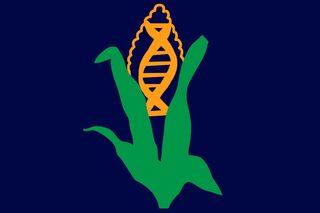
Are Genetically Modified Foods Safe?
I was skeptical. So I did some research.

When I hear the term ‘genetically modified organism’ or, more colloquially, GMO, my instant reaction is wariness. I imagine veggies larger than life, extra shiny and oddly tasteless – just like a toy or wax replica. To me, GM foods symbolize something that has been unnaturally beautified or beefed up. However, with news that India’s genetically modified crop area is now the fifth-largest in the world, I decided a little research was long due.
What are GM foods?
GM foods are any edible plant whose DNA has been altered via genetic engineering. These tweaks might involve deleting certain genes, or selecting and transferring genes between plants, or even species. For instance, genes that make wheat susceptible to certain disease might be simply deleted. Or, genes from wheat with certain advantageous qualities might be transferred to another type of wheat. Or, genes from certain bacteria might be added to, say, brinjal, to give it insect-repellent properties. Most GM food is modified in a way that makes the crop hardier, with higher yield, and/or resistant to diseases, pests and herbicides.
Why do they exist?
Genetic modification of crops is a modern twist on the centuries’ old practice of selective breeding. It’s just a faster and more targeted way to produce crops with specific qualities that benefit producers or consumers. Proponents of GM foods say yield gains benefit farmers, especially in developing countries, and increase a population’s food supply. Also, some food crops have been modified to contain additional nutrients beneficial to consumers, but none of these are currently commercially available.
Are there GM versions of all foods?
Presently, there are only a handful of GMO food crops that are commercially available. The only GM crop grown in India is inedible – cotton – though the country might approve its first GM food crop, GM Mustard, next year. But around the world, only GM versions of corn, soybeans, canola, alfalfa, sugar beets, papaya, squash, brinjal, apples and potatoes are currently grown. Corn and soybeans are the most commonly grown GM food crops across the 30 countries that grow GM crops.
Are all of these GM foods available in India?
Technically, importing GM foods and food stuffs is banned by the Food Safety and Standards Authority of India, and since no GM food crops are grown in India yet, GM foods should not be available. However, in 2017, it emerged that the government had been importing large amounts of oils made from GM soybeans and GM canola for years, disregarding FSSAI regulations.
These regulations, clearly, are not well enforced. And since India has yet to finalize rules that require all products that contain GM foods be labelled (as 64 other countries do), it’s entirely possible that domestic processed foods may contain GM soybean and canola oils. It’s also possible that imported food (say, brinjal from Bangladesh) is GM, or imported processed food stuffs contain GM ingredients.
Are GM foods as nutritious as non-GM foods?
Yes. Most GM crops have been modified for reasons entirely unrelated to nutrition, and it’s never been proven those modifications lessen the plant’s inherent nutritional value.
Some are actually more nutritious. The GM soybean that makes the oil the government has been importing on the sly is the first-to-market crop manipulated to be more nutritious — free of trans fats, it has a health profile on par with olive oil. Other crops have been genetically engineered to add nutritional value, but none are currently approved for market.
Are GM foods safe?
Earlier this year, a meta-analysis of more than 6,000 peer-reviewed studies spanning more than two decades led its authors to conclude that GM corn is perfectly safe for human consumption. The breadth of the analysis, and the inclusion of only high-quality studies, allowed them “to draw unequivocal conclusions, helping to increase public confidence in food produced with genetically modified plants,” they wrote.
In fact, there’s a chance that GM corn might be slightly safer than regular corn. The analysis found GM corn contains significantly fewer mycotoxins, which are both toxic and carcinogenic for humans, than non-GMO corn. Mycotoxins are typically rinsed from non-GMO food prior to eating, but there is a still a risk.
GM crops are put through rigorous health and environmental evaluation before being approved for market. The number of GM crops developed exceeds the number of GM crops actually approved for cultivation and consumption.
Opponents of GM foods argue genetically modifying crops has the potential to create new allergens; per the World Health Organization, no allergic effect has been found in any currently marketed GM food. They also point to the potential for the transfer of antibiotic-resistant genes from GM food to the body’s cells or gut bacteria; again, per the WHO, the probability of such transfer is low, but to be on the safe side, the use of antibiotic-resistant genes in modification is discouraged. A study in 2013 suggested a link GM corn to cancer in rats, but the journal ultimately retracted the study for a variety of reasons – one of which was the fact that the rats used in the study were prone to cancer anyway. Other studies carried out on lab rats, found GMO foods have no relation to any form of cellular mutation, or impact on body organ functioning.
Angelina Shah is a staff writer with The Swaddle. In her previous life she was a copywriter in advertising. She has a penchant for reading, singing, travelling and being obsessed with superheroes.
Related


IBM’s Watson for Cancer Care Said to Have Recommended Unsafe Treatments
